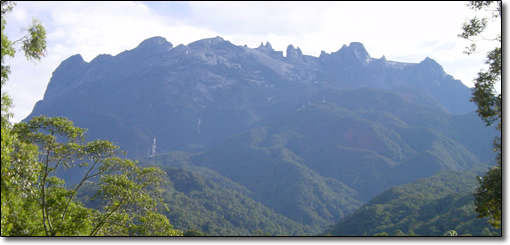
Mt Kinabalu
At 4095 m, the massive Mt. Kinabalu soars above the surrounding country. From the park headquarters, the summit ridge looks like a giant theme park, full of strange, polished rock formations. Every day hundreds of tourists, mostly Asians, climb the summit. To avoid the crowds, we stayed at the Mesilau station. At 2000m, Mesilau is the start of an alternative trail to the Kinabalu summit and also the only place to see the largest species of pitcher plant, the Nepenthes Raja. A knowledgeable ranger took us to see the plants. After unlocking the gate leading to the trail, we climbed an exposed hillside. In the scrub sat large, pot-shaped pitchers, big enough to put your fist in. The ranger also pointed out a slipper orchid, one of the most beautiful - and most wanted by collectors. As we made our way back to the station, clouds rolled in and it started to rain.
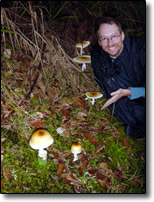 |
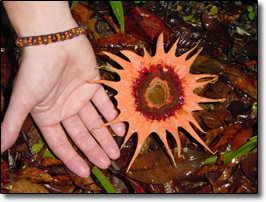 |
The next morning we started out for the base camp of Mt Kinabalu. Before we could depart, we needed a permit from the park office. Officially, a guide is required for the summit, but we knew that if you sign an indemnity form, you could avoid the extra expense. The trail is easy to follow and there is no need for a guide. Still, they insisted that Anne speak on the phone to someone important from park headquarters:
Ranger: Have you ever climbed Kinabalu?
Anne: No.
Ranger: You have to take a guide. Where are you from?
Anne: Switzerland. We have climbed plenty of mountains there.
Ranger: Ok, but you have to take a guide.
Anne: I know, you already told me. Do you have anything else to say?
Ranger: No.
Anne: Ok, goodbye! (Hangs up)
That settled it. Permits in hand, we set off. The Mesilau trail is less frequented because it is longer. Another large group was ahead of us on the trail. About an hour after setting off, we met a man coming down the trail. When I started to ask him about the summit and trail conditions, he sheepishly admitted that he had left that morning, found the trail too hard and had just turned around! Soon we caught up with the others, a group of Malaysians from the peninsula. “Where is your guide?” By keeping a steady, unbroken rhythm, I found that I could pass the others, who alternated bursts of activity with long, panting pauses. There were plenty of pitcher plants to keep us entertained along the way. Nepenthes Lowii has a thick, ridged collar and likes to grow in the high cloud forest. The stunted trees, dripping with moss, were filled with wild orchids. Eventually we joined the main trail and started to climb to the summit base camp. At about 3000m, just shy of the Laban Rata camp, we were caught in a cold, icy rain. By the time we arrived, we were soaked. After being so long in the hot tropics, it was difficult to endure the chill. Luckily there was a vacancy in the hostel with heaters, but only one bed! We didn't have to share, though, as another bed in the same room was never claimed. It seems that many who set out from park headquarters with reservations become discouraged and turn back. With a makeshift clothesline our gear was soon steaming over the heater. To cook dinner we used the kitchen in the other, unheated hostel, where hikers sat shivering in their wet clothes. In our overheated room, it was too hot to sleep!
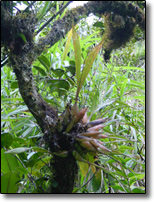 |
 |
Already at 2am, with lights and slamming doors, it was impossible to sleep any more. We started the trail to the summit at 3am, well after most of the Asians. It wasn't long before we were passing them on the steep, narrow trail. Several had given up and were already on their way down. The trail became steeper. There were wooden stairs bolted to the rock, their planks slippery after the nocturnal rain. A long line of climbers backed up on these sections as the fearful picked their way up the mountain. It was chilly, but with the effort we felt warm enough. At one point we came across a steep rock slope, with only chains and ropes to hold while climbing. After passing the final checkpoint, we clambered above tree line onto a wonderland of sloping, rough-polished granite. We could see the sculpted forms of the summit moonscape in the starlight. Although there was a rope to hold on to, the rock was rough enough for our shoes to grip without slipping. Here the slope of the mountain was deceptive. The summit appeared tantalizingly close, but there was still plenty of elevation to gain. We followed the white rope in the dim light. Near the end, all that remained was a pile of boulders: one final scramble and we were there, well before sunrise.
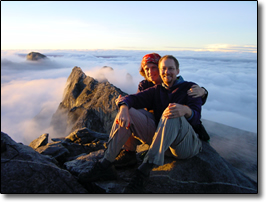 |
 |
It had taken us a little more than two hours to make the climb, and we still had almost an hour to wait. We changed our shirts, put on all of our clothes, and sat shivering on the rocks overlooking Low's Gully, a deep, menacing cataract, now filled with fog. The lights of Kota Kinabalu twinkled in the distance, far below us. Some Malaysians wanted to take their picture with us. As the sun slowly rose, a thick layer of clouds rolled in, obscuring the view below. At 6am, just as the first rays of the sun were starting to warm our backs, we started our descent. On the way down strange, sculpted granite forms, such as the “Donkey's Ears”, appeared in the morning light.
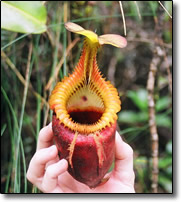 |
 |
We stopped at Laban Rata to have breakfast. Then we headed back to Mesilau. As we climbed down the steep trail, it was hard to believe that we had climbed so much the day before. The trail seemed to go on and on. Our legs creaked as we descended onto a high ridge, then into a steep valley. We crossed a bridge and then climbed up again before the final descent to Mesilau, where we grabbed our bags and hitched a ride straight to the Poring hot springs . We rented a private room and relaxed our aching legs in the hot, soothing water. Our tub was shaped like a giant Raffalesia flower!
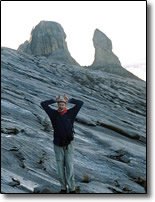 |
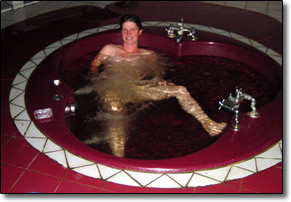 |
